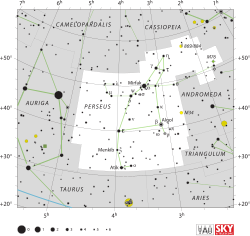11 Persei
| 11 Persei | |
 | |
| Observationsdata Epok: J2000.0 | |
|---|---|
| Stjärnbild | Perseus |
| Rektascension | 02t 43m 02,83826s[1] |
| Deklination | +55° 06′ 21,6700″[2] |
| Skenbar magnitud () | +5,76 [3], +5,753 ± 0,009 (Hp)[2] |
| Stjärntyp | |
| Spektraltyp | B7 III(p?) (Hg?)[4], |
| B–V | -0,110 ± 0,003[5] |
| Astrometri | |
| Radialhastighet () | -0,70 ± 1[3] km/s |
| Egenrörelse (µ) | RA: 34,859 ± 0,166[1] mas/år Dek.: -21,955 ± 0,182[1] mas/år |
| Parallax () | 7,8022 ± 0,0874[1] |
| Avstånd | 418 ± 5 lå (128 ± 1 pc) |
| Absolut magnitud () | 0,16[3] |
| Detaljer | |
| Massa | 3,77 ± 0,06[6] M☉ |
| Radie | 3,2[7] R☉ |
| Luminositet | 210,4+21,9-19,9[6] L☉ |
| Temperatur | 14 550[8] K |
| Metallicitet | +0,09 (Fe/H)[8] dex |
| Vinkelhastighet | 4,50[9] km/s |
| Ålder | 50,9 ± 12,2[10] miljoner år |
| Andra beteckningar | |
| GCRV 53324, HR 785, TYC 3704-1333-1, AG+54 318, GEN# +1.00016727, 2MASS J02430282+5506217, UBV 2663, ALS 16543, GSC 03704-01333, PPM 27908, UBV M 9096, BD+54 598, HD 16727, Renson 4210, uvby98 100016727, CEL 293, HGAM 163, SAO 23555, WEB 2578, FK5 2188, HIC 12692, SKY# 4070, YZ 54 1245, GC 3253, HIP 12692, TD1 1582, Gaia DR2 454385485266854016[2][11] | |
11 Persei, som är stjärnans Flamsteed-beteckning, är en ensam stjärna[12] belägen i den nordvästra delen av stjärnbilden, Perseus.[13] Den har en skenbar magnitud på ca 5,76[3] och är svagt synlig för blotta ögat där ljusföroreningar ej förekommer. Baserat på parallax enligt Gaia Data Release 2 på ca 7,8[1] mas, beräknas den befinna sig på ett avstånd på ca 418 ljusår (ca 128 parsek) från solen. Den rör sig bort närmare solen med en heliocentrisk radialhastighet av ca –0,7 km/s.[3]
Egenskaper[redigera | redigera wikitext]
11 Persei är vit till blå stjärna i huvudserien av spektralklass B7 III(p?) (Hg?),[4][14] även om Hube (1970) gav den spektralklass B8 IV[15] och Appenzeller (1967) klassade den som B6 V.[16] Stjärnan är en kemiskt speciell kvicksilver-mangan-stjärna.[8][14] Den har en massa som är ca 3,8[6] solmassor, en radie som är ca 3,2[7] solradier och utsänder ca 210[6] gånger mera energi än solen från dess fotosfär vid en effektiv temperatur på ca 14 600 K.[8]
Referenser[redigera | redigera wikitext]
- Den här artikeln är helt eller delvis baserad på material från engelskspråkiga Wikipedia, 11 Persei, 19 juli 2020.
Noter[redigera | redigera wikitext]
- ^ [a b c d e] Brown, A. G. A.; et al. (Gaia collaboration) (August 2018). "Gaia Data Release 2: Summary of the contents and survey properties". Astronomy & Astrophysics. 616. A1. arXiv:1804.09365. Bibcode:2018A&A...616A...1G. doi:10.1051/0004-6361/201833051. Gaia DR2 record for this source at VizieR.
- ^ [a b c] ”Basic data: * 11 Per – Star” (på engelska). Centre de Données astronomiques de Strasbourg. http://simbad.u-strasbg.fr/simbad/sim-basic?Ident=11+Per&submit=SIMBAD+search. Läst 24 februari 2019.
- ^ [a b c d e] Anderson, E.; Francis, Ch. (2012), "XHIP: An extended hipparcos compilation", Astronomy Letters, 38 (5): 331, arXiv:1108.4971, Bibcode:2012AstL...38..331A, doi:10.1134/S1063773712050015.
- ^ [a b] Cowley, A. (November 1972), "Spectral classification of the bright B8 stars", Astronomical Journal, 77: 750–755, Bibcode:1972AJ.....77..750C, doi:10.1086/111348.
- ^ van Leeuwen (2007). ”Hipparcos, the New Reduction” (på engelska). http://vizier.u-strasbg.fr/viz-bin/VizieR-5?-out.add=.&-source=I/311/hip2&HIP=12692. Läst 24 februari 2019.
- ^ [a b c d] Zorec, J.; Royer, F.; Asplund, Martin; Cassisi, Santi; Ramirez, Ivan; Melendez, Jorge; Bensby, Thomas; Feltzing, Sofia (2012), "Rotational velocities of A-type stars. IV. Evolution of rotational velocities", Astronomy and Astrophysics, 537: A120, arXiv:1201.2052, Bibcode:2012A&A...537A.120Z, doi:10.1051/0004-6361/201117691.
- ^ [a b] Pasinetti Fracassini, L. E.; et al. (February 2001), "Catalogue of Apparent Diameters and Absolute Radii of Stars (CADARS)", Astronomy and Astrophysics (Third ed.), 367: 521–524, arXiv:astro-ph/0012289, Bibcode:2001A&A...367..521P, doi:10.1051/0004-6361:20000451.
- ^ [a b c d] Ghazaryan, S.; Alecian, G. (2016), "Statistical analysis from recent abundance determinations in HgMn stars", Monthly Notices of the Royal Astronomical Society, 460 (2): 1912, Bibcode:2016MNRAS.460.1912G, doi:10.1093/mnras/stw911.
- ^ Hubrig, S.; Castelli, F. (September 2001), "New results of magnetic field diagnosis in HgMn stars and normal late B-type stars", Astronomy and Astrophysics, 375: 963–976, Bibcode:2001A&A...375..963H, doi:10.1051/0004-6361:20010894.
- ^ Tetzlaff, N.; et al. (January 2011), "A catalogue of young runaway Hipparcos stars within 3 kpc from the Sun", Monthly Notices of the Royal Astronomical Society, 410 (1): 190–200, arXiv:1007.4883, Bibcode:2011MNRAS.410..190T, doi:10.1111/j.1365-2966.2010.17434.x.
- ^ "11 Per". SIMBAD. Centre de données astronomiques de Strasbourg. Hämtad 2019-03-28.
- ^ Eggleton, P. P.; Tokovinin, A. A. (September 2008), "A catalogue of multiplicity among bright stellar systems", Monthly Notices of the Royal Astronomical Society, 389 (2): 869–879, arXiv:0806.2878, Bibcode:2008MNRAS.389..869E, doi:10.1111/j.1365-2966.2008.13596.x.
- ^ Wahlgren, Glenn Michael; et al. (January 2012), "Emission Line Variability In The HgMn Star 11 Per", American Astronomical Society, AAS Meeting #219, Bibcode:2012AAS...21943904W, 439.04.
- ^ [a b] Adelman, S. J.; Yüce, K. (August 2010), "Elemental abundance analyses with Coudé Echelle spectrograms from the TÜBİTAK National Observatory of Turkey: I. The HgMn stars 11 Per, HR 2801, and ν Cnc", Astronomische Nachrichten, 331 (8): 785–793, Bibcode:2010AN....331..785A, doi:10.1002/asna.201011411.
- ^ Hube, Douglas P. (1970), "The radial velocities of 335 late B-type stars", Memoirs of the Royal Astronomical Society, 72: 233–280, Bibcode:1970MmRAS..72..233H.
- ^ Appenzeller, Immo (April 1967), "MK Spectral Types for 185 Bright Stars", Publications of the Astronomical Society of the Pacific, 79 (467): 102, Bibcode:1967PASP...79..102A, doi:10.1086/128449.





